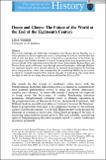Doom and gloom : the future of world at the end of the eighteenth century
Abstract
This article challenges the widely held assumption that Thomas Robert Malthus was a lonely pessimist in the late eighteenth century. Interpreting the sources that Malthus had used to write his Essay on the Principle of Population as predictions of the future, the article argues that Malthus inherited a sense of looming doom from his predecessors. In the second half of the eighteenth century, David Hume, Adam Smith, Richard Price, and Thomas Paine predicted Britain's ruin through national bankruptcy. Although Malthus, too, expressed anxiety about excessive growth, he changed the parameters by worrying about overpopulation, rather than overspending. By considering Malthus in the context in which he originally formulated his famous principle of population, this article sheds new light on what he was doing when he first published his Essay in 1798.
Citation
Weber , L 2021 , ' Doom and gloom : the future of world at the end of the eighteenth century ' , History , vol. 106 , no. 371 , pp. 409-428 . https://doi.org/10.1111/1468-229X.13173
Publication
History
Status
Peer reviewed
ISSN
0018-2648Type
Journal article
Collections
Items in the St Andrews Research Repository are protected by copyright, with all rights reserved, unless otherwise indicated.

